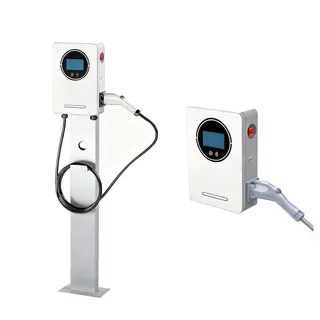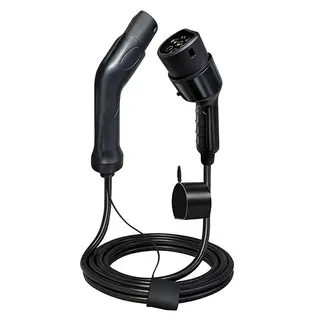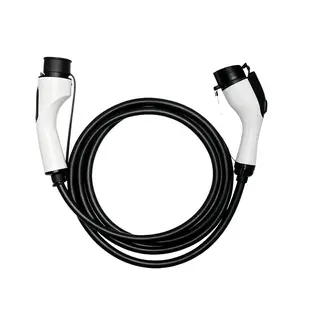As new energy vehicles gradually become the mainstream mode of transportation today, home EV chargers, as key equipment for enhancing the convenience of vehicle use, have attracted the attention of many car owners. However, when selecting a home EV charger, we often face a dilemma: should we choose a model with a display screen or one without? Next, let's explore the characteristics of these two types of EV chargers in depth to help you find the one that best suits you.
Among many home EV chargers, screen-equipped EV chargers have become the first choice for many car owners due to their unique functions and intelligent operation. So, what are the advantages of EV chargers with screens? Why can they be considered effective assistants for smart charging? Next, lets explore the appeal of screen-equipped EV chargers.
The biggest advantage of EV chargers with screens lies in their intuitive visual interface. Most are equipped with color LCDs or LED digital displays that can show key real-time charging data such as charging current, voltage, energy delivered, remaining charging time, and instantaneous power. For example, with a certain brand of screen-equipped EV charger, during charging, the car owner only needs to glance at the screen to clearly understand the charging progress, such as displaying "30 kWh charged, 2 hours remaining." This intuitive presentation of information allows car owners to be fully aware of the charging status without needing to check a mobile app or the vehicle dashboard, greatly improving the convenience of the charging process.
In addition to intuitive display functions, EV chargers with screens usually also offer menu operation functions. Through screen buttons or touch operation, multiple settings can be adjusted. For example, the charging mode (immediate or scheduled) can be set, allowing car owners to flexibly choose charging times according to their needs and electricity peak and off-peak periods, saving on electricity costs and planning charging schedules reasonably. Charging current can also be adjusted (within grid limits or vehicle support) to suit different charging scenarios and avoid overloading the power grid. Charging history can be reviewed to help car owners understand their charging habits and energy consumption, providing reference for future travel planning. Some high-end screen-equipped EV chargers even support fault code display; when a fault occurs, the screen shows a specific code, such as "E01" representing a charging circuit fault, allowing car owners or maintenance personnel to quickly locate problems and improving troubleshooting efficiency.
Many screen-equipped EV chargers, in order to support their rich screen functions, are equipped with advanced main control chips and communication modules, giving them advantages in compatibility and expandability. For example, some support OTA (over-the-air) firmware upgrades, allowing new functions to be added or existing ones optimized, such as adding support for new vehicle charging protocols or improving charging strategies. Moreover, EV chargers with screens have greater potential for integration with smart home systems. In the future, they may interact with smart speakers, smart locks, and other devices, for example, enabling voice control to start or stop charging, or automatically sending notifications to smart home terminals when charging is complete, further enhancing the intelligent experience of use.
However, not all car owners pursue complex functions and intelligent operation. For some users who value practicality and ease of operation, EV chargers without screens, with their simple design and straightforward operation, become an ideal choice for meeting basic charging needs, showcasing the charm of simplicity and practicality.
Screenless EV chargers focus on basic charging functions, with the core task of safely and stably charging the vehicle. These EV chargers usually use indicator lights to show operational status: solid green indicates standby, blinking blue indicates charging, and solid red indicates a fault. Although they do not display rich screen data, basic charging information, such as the start and end of charging, can be obtained via the vehicle dashboard or mobile app. For example, a popular screenless EV charger features a simple design, retaining only the necessary charging interface and indicator lights without complex screen operations. For car owners who only pursue the simple "plug and charge" experience, this minimalist design reduces unnecessary functions, lowers operational complexity, and avoids issues caused by screen malfunctions.
The operation of screenless EV chargers is essentially foolproof. Car owners simply insert the charging gun into the vehicle port, and after the indicator confirms a proper connection, charging begins automatically. When charging ends, removing the gun stops the process. The entire operation requires no complex steps. This simple and direct approach is very appealing to elderly users or those less familiar with electronic products, with almost no learning curve, significantly lowering the usage threshold. Additionally, because there is no screen, there is less risk of setting errors caused by accidental touches, such as changing the charging mode unintentionally, making it worry-free. Screenless EV chargers, with their minimalist design, are more cost-effective and affordable, making them a good choice for budget-conscious car owners. Moreover, due to their simpler internal structure and fewer electronic components, they are less likely to fail. Even if a fault occurs, repair difficulty and costs are generally lower than for screen-equipped EV chargers, typically involving only the charging control module or cables, and repair time is shorter, allowing quicker return to use.
Screenless EV chargers have a relatively compact and simple structure, reducing safety risks potentially caused by complex components such as screens. Their internal circuitry is simple, with few electronic parts, lowering the likelihood of safety issues. Additionally, without a screen, there are no concerns about waterproofing or dust protection for the display, offering higher safety when used outdoors or in harsh environments. Regardless of whether an EV charger has a screen or not, it is essential that it is certified under relevant national safety standards (such as 3C certification) and installed and used according to regulations to ensure maximum charging safety.
When faced with the choice between EV chargers with screens and those without, decisions should be based on your needs, usage habits, budget, and future plans. Here are some specific recommendations to help you determine which EV charger suits you best:
If you are a technology enthusiast, pursuing intelligent and convenient charging, and like to view charging data in real-time while customizing settings, an EV charger with a screen is undoubtedly more suitable. Its rich functions and expandability can meet your exploration of new technologies and features, and touch-screen operation aligns with the habits of younger users. A screen-equipped EV charger can provide more convenience and enjoyment, allowing you to experience technology even during charging.
For elderly car owners or users who value practicality and simple operation, an EV charger without a screen is a better choice. Its straightforward operation requires no learning of complex screen functions, and its "plug and charge" feature makes the charging process easy and worry-free. Additionally, its lower price and maintenance costs align with practical consumption concepts. Although screenless EV chargers have simpler functions, they fully meet daily charging needs, providing peace of mind and convenience.
If your budget for both the vehicle and EV charger installation is limited, an EV charger without a screen offers high cost-effectiveness, fulfilling basic charging needs while saving money. Its lower long-term maintenance costs also reduce economic pressure over time. While it may lack the rich features of a screen-equipped EV charger, for budget-conscious users, it is a practical and economical choice.
If you expect your EV charger to support future upgrades and expanded features, and want it to adapt to future vehicle technology, EV chargers with screens have advantages in compatibility and expandability, providing more possibilities and keeping your EV charger technologically advanced for a longer time. Choosing a screen-equipped EV charger allows you to better accommodate future charging technology changes and vehicle upgrades, ensuring your EV charger stays up-to-date.
Choosing a home EV charger requires comprehensive consideration of personal usage habits, budget, and functional needs. EV chargers with screens, with their rich functions, intelligent operation, and excellent expandability, are suitable for users seeking high-tech experiences and convenient operation. EV chargers without screens, with their simplicity, ease of use, high cost-effectiveness, and reliability, are ideal for practical users and those with budget constraints. Regardless of the type you choose, ensure the EV charger has relevant national safety certifications and is installed and used according to regulations to guarantee safe charging. We hope this article helps you make a more informed decision when selecting a home EV charger, making charging your new energy vehicle easier and more convenient.



